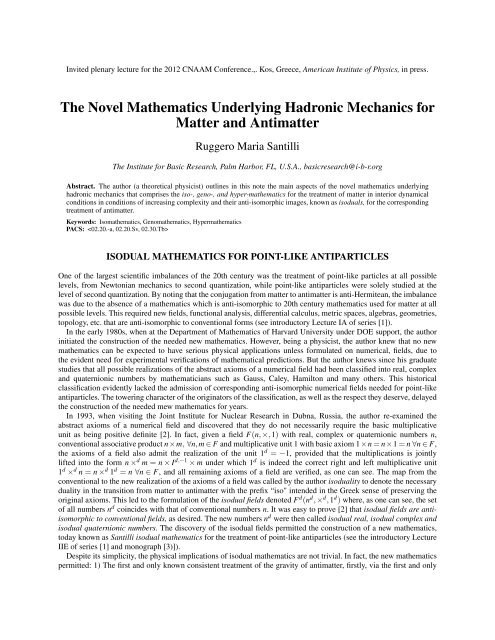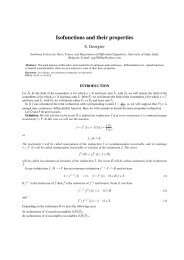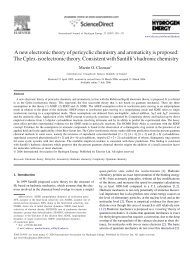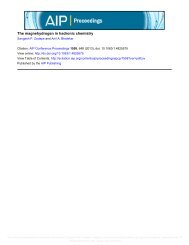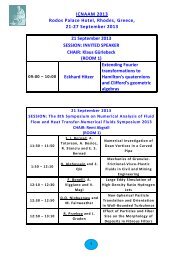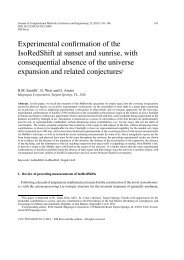Download - The RM Santilli Foundation
Download - The RM Santilli Foundation
Download - The RM Santilli Foundation
You also want an ePaper? Increase the reach of your titles
YUMPU automatically turns print PDFs into web optimized ePapers that Google loves.
Invited plenary lecture for the 2012 CNAAM Conference.,. Kos, Greece, American Institute of Physics, in press.<br />
<strong>The</strong> Novel Mathematics Underlying Hadronic Mechanics for<br />
Matter and Antimatter<br />
Ruggero Maria <strong>Santilli</strong><br />
<strong>The</strong> Institute for Basic Research, Palm Harbor, FL, U.S.A., basicresearch@i-b-r.org<br />
Abstract. <strong>The</strong> author (a theoretical physicist) outlines in this note the main aspects of the novel mathematics underlying<br />
hadronic mechanics that comprises the iso-, geno-, and hyper-mathematics for the treatment of matter in interior dynamical<br />
conditions in conditions of increasing complexity and their anti-isomorphic images, known as isoduals, for the corresponding<br />
treatment of antimatter.<br />
Keywords: Isomathematics, Genomathematics, Hypermathematics<br />
PACS: <br />
ISODUAL MATHEMATICS FOR POINT-LIKE ANTIPARTICLES<br />
One of the largest scientific imbalances of the 20th century was the treatment of point-like particles at all possible<br />
levels, from Newtonian mechanics to second quantization, while point-like antiparticles were solely studied at the<br />
level of second quantization. By noting that the conjugation from matter to antimatter is anti-Hermitean, the imbalance<br />
was due to the absence of a mathematics which is anti-isomorphic to 20th century mathematics used for matter at all<br />
possible levels. This required new fields, functional analysis, differential calculus, metric spaces, algebras, geometries,<br />
topology, etc. that are anti-isomorphic to conventional forms (see introductory Lecture IA of series [1]).<br />
In the early 1980s, when at the Department of Mathematics of Harvard University under DOE support, the author<br />
initiated the construction of the needed new mathematics. However, being a physicist, the author knew that no new<br />
mathematics can be expected to have serious physical applications unless formulated on numerical, fields, due to<br />
the evident need for experimental verifications of mathematical predictions. But the author knews since his graduate<br />
studies that all possible realizations of the abstract axioms of a numerical field had been classified into real, complex<br />
and quaternionic numbers by mathematicians such as Gauss, Caley, Hamilton and many others. This historical<br />
classification evidently lacked the admission of corresponding anti-isomorphic numerical fields needed for point-like<br />
antiparticles. <strong>The</strong> towering character of the originators of the classification, as well as the respect they deserve, delayed<br />
the construction of the needed mew mathematics for years.<br />
In 1993, when visiting the Joint Institute for Nuclear Research in Dubna, Russia, the author re-examined the<br />
abstract axioms of a numerical field and discovered that they do not necessarily require the basic multiplicative<br />
unit as being positive definite [2]. In fact, given a field F(n,×,1) with real, complex or quaternionic numbers n,<br />
conventional associative product n×m, ∀n,m ∈ F and multiplicative unit 1 with basic axiom 1×n = n×1 = n ∀n ∈ F,<br />
the axioms of a field also admit the realization of the unit 1 d = −1, provided that the multiplications is jointly<br />
lifted into the form n × d m = n × I d,−1 × m under which 1 d is indeed the correct right and left multiplicative unit<br />
1 d × d n = n × d 1 d = n ∀n ∈ F, and all remaining axioms of a field are verified, as one can see. <strong>The</strong> map from the<br />
conventional to the new realization of the axioms of a field was called by the author isoduality to denote the necessary<br />
duality in the transition from matter to antimatter with the prefix “iso" intended in the Greek sense of preserving the<br />
original axioms. This led to the formulation of the isodual fields denoted F d (n d ,× d ,1 d ) where, as one can see, the set<br />
of all numbers n d coincides with that of conventional numbers n. It was easy to prove [2] that isodual fields are antiisomorphic<br />
to conventional fields, as desired. <strong>The</strong> new numbers n d were then called isodual real, isodual complex and<br />
isodual quaternionic numbers. <strong>The</strong> discovery of the isodual fields permitted the construction of a new mathematics,<br />
today known as <strong>Santilli</strong> isodual mathematics for the treatment of point-like antiparticles (see the introductory Lecture<br />
IIE of series [1] and monograph [3)]).<br />
Despite its simplicity, the physical implications of isodual mathematics are not trivial. In fact, the new mathematics<br />
permitted: 1) <strong>The</strong> first and only known consistent treatment of the gravity of antimatter, firstly, via the first and only
known formulation of Newton’s equations for antiparticles, the isodual Newton equations, and then via the isodual<br />
Riemannian geometry; 2) <strong>The</strong> first consistent prediction at all levels, from Newtonian to Riemannian formulations,<br />
of gravitational repulsion (antigravity) for antimatter in the field of matter or vice-versa; 2) <strong>The</strong> prediction that light<br />
emitted by antimatter, the isodual light, is different than that emitted by matter, e.g., because experiencing gravitational<br />
repulsion; and other intriguing implications [3].<br />
To illustrate the societal implications, recall that Einstein special and general relativity: A) Where formulated before<br />
the discovery of antimatter; B) Contain no quantitative means for differentiating between neutral matter and antimatter;<br />
and, consequently, C) <strong>The</strong>y cannot make any distinction between light emitted by matter and that by antimatter. But<br />
our planet has been devastated in the past by antimatter asteroids, as it is the case for the 1908 Tunguska explosion<br />
in Siberia, that was the equivalent to 1,000 atomic bombs, yet left no crater or debris whatsoever in the ground, thus<br />
being solely representable on quantitative grounds via the explosion of an antimatter asteroid in our matter atmosphere.<br />
Recent studies via isodual mathematics have shown that matter light, such as that of our Sun, is predicted as being<br />
absorbed (“annihilated") when hitting an antimatter asteroid without refraction [4], thus indicating that we cannot<br />
necessarily view antimatter asteroids with Sun light. Consequently, a possible insistence in the final character of 20th<br />
century mathematics could, in the extreme, endanger the very existence of our planet.<br />
ISOMATHEMATICS FOR EXTENDED PARTICLES IN REVERSIBLE CONDITIONS<br />
When at Harvard University from 1977 to 1981, the DOE requested the author to initiate studies that could lead in due<br />
time to new clean energies, with particular reference to new controlled fusions and other energy releasing processes.<br />
For this objective, the author initiated the study of the simplest possible fusions, those of strongly interacting particles<br />
(hadrons)i, also called hadron syntheses, such as the synthesis of the π 0 meson, e + + e − → π 0 , the synthesis of<br />
the neutron from a hydrogen atom as occurring in stars, p + + e − → n + ν, and other syntheses. the ne4ed for these<br />
preparatory studies originated from the fact that the synthesis of the neutron inside a star is a necessary prerequisite<br />
for all subsequent nuclear fusions producing light, such as the synthesis of deuterium, helium, etc.<br />
To his surprise, the author discovered (see memoirs [5,6] of 1978) that the theory of Hilbert spaces over a numerical<br />
field, and particularly the Schrödinger equation, are inapplicable to said hadron syntheses because the rest energies<br />
of the final states are bigger than the sum of the rest energies of the initial states (e.g., the rest energy of the π 0 is<br />
134 MeV while the sum of the rest energies of the electron and positron is 1.02 MeV ). By recalling that all consistent<br />
quantum mechanical bound states in particle, nuclear and molecular physics require a negative binding energy, with<br />
consequential mass defect (namely, the rest energy of the final states are smaller than the sum of the rest energies of<br />
the original states), the above conditions precluded any quantitative study of hadron syntheses via the mathematics<br />
underlying quantum mechanics. All attempts to achieve a quantum mechanical solution on a Hilbert space over a<br />
field failed for various reasons, e.g., the representation of the missing energy via the relative kinetic energy of the<br />
constituents was prohibited by a virtually null cross section between the constituents, and for other reasons. <strong>The</strong>se<br />
difficulties identified the existence of a new fundamental open problem whose solution required the construction of<br />
a basically new mathematics structurally broader than that at the foundation of quantum mechanics (for details, see<br />
Refs. [5,6] and Lecture IB of series [1]).<br />
Following a variety of attempts, the author established in memoirs [5.6] that the representation of the syntheses<br />
e + + e − → π o , p + + e − → n + ν and others required the exiting from the class of unitary equivalence of quantum<br />
mechanics. <strong>The</strong> only certain way to assure such a departure was that via a a non-unitary covering of quantum<br />
mechanics, proposed by the author under the name of hadronic mechanics because intended for the study of the<br />
structure of hadrons, for the so-called interior dynamical problems at large. In turn, such a new mechanics evidently<br />
required a new non-unitary image of the mathematics underlying quantum mechanics. In fact, a nonunitary image of<br />
Schrödinger’s equation provided the representation of all characteristics of the π 0 meson via its indicated synthesis<br />
(see Section 5 of Ref. [6]), while the synthesis of the neutron had to be delayed to subsequent studies because it<br />
requires a non-unitary lifting of Lie’s theory with particular reference to the nonunitary formulation of the SU(2)-spin<br />
and other spacetime symmetries.<br />
<strong>The</strong> main proposal of Refs. [6] was the non-unitary lifting the conventional associative product A × B between two<br />
generic non-singular quantities A,B (operators, matrices, vector fields, etc.) of the form A×B → U ×(A×B)×U † =<br />
 ˆ× ˆB = Â× ˆT × ˆB,  = U ×A×U † , ˆB = U ×B×U † , ˆT = (U ×U † ) −1 under the basic conditions that the transform is<br />
non-unitary, U ×U † ≠ I, yet positive-definite for the class under consideration, U ×U † > 0. <strong>The</strong> resulting new product<br />
 ˆ× ˆB was called by the author isoproduct in the sense of being as associative as the original product AS × B. <strong>The</strong> new<br />
mathematics emerging from the systematic use of the isoproduct is today known as <strong>Santilli</strong> isomathematics.
A most important part of isomathematics introduced in detail in the original memoir [5] is given by the isotopes<br />
(intended as axiom-preserving non-unitary liftings) of Lie’s theory today known as the <strong>Santilli</strong>’s Lie-isotopic theory,<br />
including (see Refs. [10] for a detailed treatment and Lectures IIA, IIB of Series [1]):<br />
ISOENVELOPING ALGEBRAS ˆξ , characterized by the infinite-dimensional basis of ordered isomonomials<br />
I, Jˆ<br />
k , Jˆ<br />
i ˆ× Jˆ<br />
j ,... i, j,k = 1,2,...,N,i ≤ j,..., where the Js are the generators of the original Lie algebra L, as characterized<br />
by the Poincaré-Birkhoff-Witt-<strong>Santilli</strong> isotheorem.<br />
ISOLIE ALGEBRAS ˆL attached to the antisymmetric component of the isoenvelope ˆL ≈ ˆξ − , with <strong>Santilli</strong> commutation<br />
rules [ Jˆ<br />
iˆ, Jˆ<br />
j ] = Jˆ<br />
i ˆ× Jˆ<br />
j − Jˆ<br />
j ˆ× Jˆ<br />
i = Ĉi k j ˆ× Jˆ<br />
k ;<br />
ISOLIE GROUPS Ĝ characterized by the isoexponentiation (i.e., exponentiation in ˆξ ) of ˆL with elements [exp( ˆ J l ×<br />
ˆT × w i × i] × (U ×U † ), ˆT = (U ×U † ) −1 .<br />
<strong>The</strong> non triviality of the above Lie-isotopic theory is illustrated by the appearance in the exponent of the operator ˆT<br />
that, besides being positive-definite, has an otherwise unrestricted functional dependence. This feature gave hopes<br />
subsequently proved as being correct, that the covering Lie-isotopic theory could provide the invariance of nonlinear,<br />
non-local and non-Hamiltonian systems. By comparison, as it is well known, Lie’s theory can only provide<br />
the invariance of linear, local-differential and Hamiltonian systems.<br />
Despite its promising features, the original formulation of isomathematics lacked maturity for years because,<br />
again, the experimental verification of mathematical predictions required a formulation over a numerical field. Such<br />
a formulation was impossible for the earlier formulations because the systematic application of the non-unitary<br />
lifting to all possible mathematics of quantum mechanical caused the alteration of the value of the original unit<br />
1 = ¯h → ˆ1 = U ×1×U † ≠ 1. In turn, the latter caused the inability to maintain the original base field F(n,×,1), with<br />
consequential crumbling of the entire mathematical structure defined over that field.<br />
It was in this way that the author was forced to inspect again the axioms of a field by discovering in the 1993 paper<br />
[2] that such axioms do not necessarily restrict the numerical value of the unit as being ±1, since the multiplicative<br />
unit ˆ1, today called <strong>Santilli</strong> isounit, can be the most general possible integral-differential operator outside the original<br />
field, with the most general possible nonlinear and integro-differential dependence on coordinates x, velocities v,<br />
wavefunctions ψ, their derivatives ∂ψ, and other variables, ˆ1 = hat1(x,v,ψ,∂ψ,...), under the sole restriction (for the<br />
case here considered) of being positive-definite, ˆ1 ≡ ˆ1 † > 0. <strong>The</strong> verification of all axioms of a field is then assured by<br />
the non-unitary isotopic lifting of the product n×m → ˆn ˆ× ˆm, under which ˆ1 is the correct right and left multiplicative<br />
unit, ˆ1 ˆ× ˆn = ˆn ˆ×ˆ1 = ˆn ∀n ∈ F.<br />
<strong>The</strong>se conditions lead to a new class of fields, today known as <strong>Santilli</strong> isofields denoted ˆF( ˆn, ˆ×, ˆ1) with the<br />
above specified isounit and isoproduct plus elements given by isoreal, isocomplex and isoquaternionic numbers<br />
ˆn = n × ˆ1. <strong>The</strong> discovery of isofields permitted major advancements in the construction of isomathematics, including<br />
the correct formulation of the iso-Hilbert spaces, today known as Hilbert-Myung-<strong>Santilli</strong> isospaces [7]. In particular,<br />
the isonumbers permitted the experimental verification of the predictions of hadronic mechanics with ordinary numbers<br />
in view of the isotopies of the eigenvalue equations H ×|ψ > −E ×|ψ >= 0 → U ×(H ×|ψ > −E ×|ψ >= 0)×U † =<br />
Ĥ ˆ×| ˆψ > −E ×| ˆψ >= 0, where the crucial preservation of conventional eigenvalues E (the sole usable in experiments)<br />
occurs in view of the reduction Ê = E × ˆ1, Ê ˆ×| ˆψ >= E × | ˆψ >.<br />
Despite the above advances, by the mid 1990s, isomathematics was not yet mature for consistent physical applications<br />
in view of the following insufficiency. <strong>The</strong> author has indicated various times in his works that “quantum<br />
mechanics has a majestic axiomatic structure and an impeccable body of experimental verifications in the arena of<br />
exact applicability of its local-differential mathematics, point-like particles in vacuum." A reason for such historical<br />
features is that quantum mechanics predicts the same numerical values under the same conditions at different times,<br />
a physical feature expressed by the mathematical property that the eigenvalues of Hermitean operators are invariant<br />
under the one-dimensional unitary Lie group of time evolution U = exp(H × t × i). This feature was absent in<br />
the initial formulation of isomathematics because non-unitary transforms do not preserve the numerical value of the<br />
eigenvalues, as one can verify (this property is called in physics the Lopez lemma [8]). In particular, lack of invariance<br />
under non-unitary time evolutions Û = exp(Ĥ ˆ×ˆt ˆ×î) implied the verification of the so-called <strong>The</strong>orems of Catastrophic<br />
Mathematical and Physical Inconsistencies we cannot possibly review here, but which play a rather insidious role in<br />
physical applications of 21st century advances in mathematics (for a review, see Vol. I of Ref. [11]).<br />
Note that, by the mid 1990s, the author had subjected to a non-unitary isotopic lifting of all possible mathematics<br />
underlying quantum mechanics, thus being left with no other alternative than that of reinspecting the Newton-Leibnitz<br />
differential calculus. In this way, the author discovered in 1996 [9] that, contrary to a popular belief for century, the
differential calculus is indeed dependent on the assumed basic unit. This features led to the discovery of <strong>Santilli</strong><br />
differential calculus with expression of the type dˆ<br />
ˆx = ˆ1(x,v,ψ,∂ψ,....) × d[x × ˆT (x,v,ψ,∂ψ,....) that coincides with<br />
the Newton-Leibnitz differential whenever the isounit is a constant or does not depend on the differentiation variable,<br />
in which case dˆ<br />
ˆx = ˆ1 × ˆ1 −1 × dx ≡ dx, but otherwise dˆ<br />
ˆx is non-trivially different than dx. Following the discovery<br />
of the isodifferential calculus, isomathematics did achieve the minimal maturity necessary for consistent physical<br />
applications by avoiding the indicated inconsistency theorems (see monographs [10] for a mathematical review and<br />
monographs [11] for physical applications; Ref. [12] for a study of <strong>Santilli</strong> isofields by the Chinese mathematician C-X.<br />
Jiangl Ref. [13] for a study of the <strong>Santilli</strong> Lie-isotopic theory by the Greek mathematicians Gr. Tsagas and D. Sourlas;<br />
Refs. [14,15] for a study of <strong>Santilli</strong> isoalgebars and isogeometris by the Georgian mathematician J. Kadeisvili; Ref.<br />
[15] for studies on <strong>Santilli</strong>’s isotopies by the Spanish mathematicians R. M. Falcon Ganfornina and Juan Nunez Valdes;<br />
Ref. [17] for a study from the viewpoint of non-associative algebras by the Estonian mathematicians J. Lôhmus, E.<br />
Paal, and L. Sorgsepp; and general review [18] for physicists by the Ukrainian physicist I. Gandzha and the Georgian<br />
mathematician J. Kadeisvili).<br />
Recall that quantum mechanics is solely able to represent a finite number of point-like particle in vacuum because<br />
its underlying mathematics is local-differential, e.g., as it is the case for the Euclidean topology with basic unit I =<br />
Diag.(1,1,1). <strong>The</strong> representation of extended, generally non-spherical, deformable, anisotropic and inhomogeneous<br />
particles is permitted by <strong>Santilli</strong>’s isounit with realizations of the type ˆ1 = Diag.(n 2 1 ,n2 2 ,n2 3 ,n2 4 )×expF(x,v,ψ,∂ψ,...),<br />
where: n 2 1 ,n2 2 ,n2 3 represent the locally varying semiaxes of a spheroid ellipsoid; n2 4 represents the interior density;<br />
and F(x,v,ψ,∂ψ,...) represents the non-linear, non-local and non-Hamiltonian interactions. Such a representation<br />
reached mathematical maturity only following the construction of the appropriate generalized topology, today known<br />
as isotopology, by the Greek mathematicians Gr. Tsagas and D. Sourlas [13] and the Spanish mathematicians R. M.<br />
Falcon Ganfornina and J. Nunez Valdes [16] (see also Ref. [19] dedicated to the topic).<br />
An important application of <strong>Santilli</strong> Lie-isotopic theory is the solution of the historical Lorentz problem, namely,<br />
the achievement of the invariance of the local speed of light within physical media C = c/n(x, µ,τ,...), where c is the<br />
speed of light in vacuum, x the local coordinate, µ the local density, τ is the local temperature, etc. As it is well known,<br />
Lorentz was unable to solve this problem, and had to content himself with the solution of the simpler case Cc = const,<br />
in which case he reached his historical transformations at the foundation of special relativity.<br />
<strong>The</strong> author conducted comprehensive studies on the historical Lorentz problem with the following main results: a)<br />
<strong>The</strong> identification in the late 1970s of the fact that Lorentz’s failure to achieve the invariance of the locally varying<br />
speed of light C was due to the insufficiency of Lie’s theory [5]; b) <strong>The</strong> systematic construction in the 1980s of<br />
the various branches of the non-unitary isotopies of Lie’s theory as a necessary pre-requisite for the solution of<br />
Lorentz problem; c) <strong>The</strong> construction in the mid 1980s of a step-by-step non-unitary isotopic lifting of all spacetime<br />
symmetries (see monographs [10] for a review), resulting in a covering spacetime symmetry today known as the<br />
Lorentz-Poincaré-<strong>Santilli</strong> (LPS) isosymmetry; d) <strong>The</strong> proof of the universal applicability of the LPS isosymmetry to all<br />
possible spacetimes with a nonsingular symmetric metric representing closed-isolated interior dynamical systems; e)<br />
<strong>The</strong> identification of the prediction by the LPS isosymmetry of deviations from the Doppler’s shift for the propagation<br />
of light within physical media without any relative motion between the source, the frequency and the observer,<br />
today called <strong>Santilli</strong> isoshift[; f) <strong>The</strong> experimental verification of such an isoshift [20]; and g) the indication of the<br />
consequential apparent absence of the universe expansion, the acceleration of the expansion, the big bang, dark matter<br />
and dark energy, since a numerical and time invariant representation of astrophysical data are permitted by the isoshift<br />
under the admission that intergalactic spaces, innergalactic spaces and the spaces in the interior of stars, quasars and<br />
black holes, are physical media.<br />
Recall that Hole’s law on the cosmological redshift establishes the same shift under the same distance in all space<br />
directions thus implying the necessary assumption of Earth at the center of the universe. We can then say that the<br />
possible insistence on the final character of 20th century mathematics would imply a return of science to the middle<br />
ages.<br />
GENO-, AND HYPER-MATHEMATICS FOR EXTENDED PARTICLES IN<br />
IRREVERSIBLE CONDITIONS<br />
During the decades of research for the construction of isomathematics, the author knew its basic insufficiency for<br />
the primary task requested by the DOE, the study of new clean energies, since 20th century mathematics as well<br />
as isomathematics are invariant under time reversal, while all energy releasing processes are irreversible over time.
Some main insufficiency emerged in the invariance under anti-Hermiticity of the Lie product [A,B] = A × B − B × A<br />
as well as that of its isotopic generalization [ˆ, ˆB] = Â × ˆT × ˆB − ˆB × ˆT × Â for Hermitean operators, i.e., [A,B] =<br />
−[A,B] † , [ˆ, ˆB] = −[ˆ, ˆB] † . Hence, a mathematics for the quantitative treatment of irreversible processes was lacking<br />
and, therefore, it had to be built.<br />
In order to initiate a representation of irreversible processes, in his Ph. D. thesis in theoretical physics [21] the author<br />
proposed in 1967 the embedding of a Lie algebra with product [A,B] = A × B − B × A into Albert’s Lie-admissible<br />
algebras and introduced the realization (A,B) = p × A × B − q × B × A where p,q, p ± q are non-null parameters.<br />
This proposal was done at a time in which only one living mathematician (Marvin Tomber) knew the existence of<br />
Lie-admissible algebras. <strong>The</strong> uniqueness of Lie-admissible algebras (persisting to this day) was due not only to their<br />
breaking of the invariance of Lie’s product under anti-Hermiticity, but also to the fact that Lie-admissible algebras<br />
admit Lie algebras as well as Lie-isotopic algebras in their classification, thus permitting the construction of covering<br />
theories. Subsequently, when at the Department of Mathematics of Harvard University, the author introduced in 1978<br />
[5,6] the most general possible realization of Lie-admissible algebras on a field of characteristic zero with product<br />
(Aˆ,B) = A × R × B − B × S × A, where R,S,R ± S are now non-singular matrices or operators. the Lie-isotopic product<br />
is admitted for the sub case R = S and the Lie product is admitted for the simplest possible realization R = S = I.<br />
<strong>The</strong> difficulties for the construction of the mathematics suitable for the time-invariant treatment of Lie-admissible<br />
algebras turned out as being substantial (particularly for a theoretical physicist such as the author). This explains the<br />
reason for devoting considerable efforts to the construction of the “intermediate" isomathematics. A main difficulty<br />
was due to the need for embedding irreversibility in the most fundamental possible operation, the multiplication, in<br />
order to surpass the test of time. This requirement led to the assumption of the ordered product to the right for motion<br />
forward in time A > B = A×S×B and the conjugated ordered product to the left representing motion backward in time<br />
A < B = A × R×. <strong>The</strong> basic brackets were then written in the form (Aˆ,B) = A × R × B − B × S × A = A < B − B > A.<br />
Irreversibility is then assured for R ≠ S. <strong>The</strong>se initial studies reveled already in 1978 a non-trivial bi-modular stricture<br />
of Lie-admissible formulation [22] with isomodule to the right A > |ψ > and conjugated isomodule to the left<br />
< ψ| < H. Due to the inequivalence of Lie-admissible and Lie-isotopic algebras, the author suggested in Ref. [5] the<br />
term genotopy to denote the map [Aˆ,B] → (Aˆ,B) in the Greek sense of inducing, this time, new axioms. Consequently,<br />
the preceding modules were called genomodules to the right and to the left, respectively, while the underlying<br />
mathematics was called genomathematics. Despite their tentative character, these initial advances of the years 1978-<br />
1979 permitted preliminary insights in the construction today known under the name of <strong>Santilli</strong> Lie-admissible theory,<br />
that are based on the following main branches (submitted in the original proposal [5]):<br />
GENOENVELOPING ALGEBRAS TO THE LEFT AND TO THE RIGHT ( < ˆξ , ˆξ > ), each characterized by an<br />
infinite dimensional basis of genomonomials with ordered genoproduct to the left and to the right, respectively;<br />
GENOLIE ALGEBRA with closure relations (J iˆ,J j ) = C k i j × J k;<br />
GENOLIE GROUPS, with transformation law A(w) = [exp(J × S × w × i)] × A(0) × [exp(−i × w × R × J)<br />
Again, the main difficulty, that delayed studies on Lie-admissible formulations for years was the need for yet broader<br />
numerical fields, since ordinary fields and isofields were manifestly insufficient for the formulation of genomathemathics.<br />
A breakthrough occurred, again, in paper [2] of 1993 when the author discovered that the axioms of a field<br />
remain verified when one restricts all products as being ordered to the right and, separately, to the left. In this way,<br />
a conventional field F(n,×,1) can be decomposed into two separate fields F(n,>,1) and F(n, m and, separately, to the left n < n. <strong>The</strong> preceding discovery of isofields then<br />
allowed the formulation in Ref.. [2] of yet new fields, today known as <strong>Santilli</strong> genofields to the right and to the left,<br />
ˆF > ( ˆn > ,>, ˆ1 > ), < ˆF( < ˆn,
produce no harmful radiations, and release no radioactive waste. <strong>The</strong> new fusion was first submitted in Ref.. [25]; it<br />
was verified by three independent nuclear physicists from Princeton Gamma Technologies in Ref. [36]; and confirmed<br />
again by the author in Ref. [27[ (see also Lecture by L. Ying VE of lecture series [1]).<br />
Despite its rather broad character, genomathematics emerged as having its own limitations for the treatment of<br />
irreversible natural processes with particular reference to biological organisms. In particular, a main limitation was its<br />
single-valuedness, in the sense that the genoproduct produces one single result. Such a single-valuedness prevented<br />
the representation of the growth in time of biological structures such as seashells. <strong>The</strong> increase of space dimensions<br />
was prohibited by our sensory perception that restricts space as being three-dimensional. <strong>The</strong> solution proposed by<br />
the author in memoir [9] is based on the assumption of a multi-valued three-dimensional genounit called hyper-unit to<br />
the right for forward time evolution, consisting of the three-dimensional expressions of the type ˆ1 > = {n > 1 ,n> 2 ,n> 3 },<br />
each component being multivalued in such a way that space remains three-dimensional at the abstract level, thus<br />
achieving compatibility of multi-valuedness with our sensory perception. We then have the corresponding multi-valued<br />
multiplication to the right n > m = n × ˆ1 >−1 × m = {c > 1 ,c> 2 ,c> 3<br />
}, each component having an ordered set of values.<br />
<strong>The</strong>se studies were then applied to the hyper-lifting of Lie’s theory in Ref. [28] with T. Vougiouklis (see the review by<br />
the Iranian mathematician M. Davvaz [29]). Note that hyper-mathematics is different than 20th century hyperstructures<br />
(see, e.g., Ref. [30]) on various counts, such as the formulation of the former over a hyperfield and the use of ordinary<br />
operations, compared to the absence of a field in the latter and the use of generalized hyperoperations.<br />
A primary hope of hyper-numbers and hyper-mathematics is that of permitting, at some future time, the initiation<br />
of studies for the understanding of the DNA code, whose complexity, in the author’s view, may prevent any insight via<br />
20th century mathematics.<br />
ISODUAL ISO-, GENO-, AND HYPER-MATHEMATICS FOR ANTIPARTICLES<br />
Physical applications generally require the parallel treatment of particles and antiparticles, as it is the case for inelastic<br />
scattering processes. By recalling that charge conjugation on a Hilbert space over a field is given by Cψ(x) = −ψ † (x),<br />
this needed mathematics was reached via the image of the iso-m geno- and hyper-mathematics characterized by the<br />
application of the isodual maps to generic operator O(x,v,ψ,...) → O d (x s ,v s ,ψ d ,...) = −O † (−x † ,−v † ,−ψ ] dag,...)<br />
as well as to all their operations based on the product. For brevity we refer the interested colleague to monograph [3].<br />
We merely mention that charge conjugation solely applies on a Hilbert space over a field, while isoduality applies at all<br />
levels of treatment, from Newton to second quantization. Also note that charge conjugation is an anti-automorphism,<br />
thus physically implying the assumption that antiparticles exist in the same spacetime of particles, while isoduality<br />
conjugates spacetime, by providing in this way a first example of two-valued hyper-universe made of coexisting matter<br />
and antimatter [31].<br />
CONCLUDING REMARKS<br />
<strong>The</strong> novel mathematics indicated in this note have been mostly developed by physicists out of specific physical needs<br />
connected to the novel discipline known as hadronic mechanics for the treatment of matter and antimatter in interior<br />
dynamical conditions of increasing complexities. Consequently, said new mathematics require a reinspection and<br />
proper formulation by mathematicians. Additionally, among a variety of intriguing open problems we indicate the<br />
following:<br />
1) <strong>The</strong> possible completion with the inclusion of exceptional Lie algebras of the unification proposed by <strong>Santilli</strong> [5]<br />
and initiated by Gr. Tsagas [32] of all simple Lie algebras of dimension N into one single <strong>Santilli</strong> isotope of the same<br />
dimension;<br />
2) <strong>The</strong> extension of isotopology [19] to the case of time irreversible systems of extended particles under the expected<br />
name of genotopology;<br />
3) <strong>The</strong> completion of the construction of the Lie-admissible covering of the Lie and Lie-isotopic theory with<br />
particular reference to its genorepresentations over bimodules [22,23].<br />
REFERENCES<br />
1. John Pace, Chairman, World Lecture Series http://www.world-lecture-series.org/
2. R. M. <strong>Santilli</strong>, Algebras, Groups and Geometries 10, 273 (1993), http://www.santilli-foundation.org/docs/<strong>Santilli</strong>-34.pdf<br />
3. R. M. <strong>Santilli</strong>, Isodual <strong>The</strong>ory of Antimatter with Applications to Antigravity, Grand Unifications and Cosmology, Springer<br />
(2006).<br />
4. R. M. <strong>Santilli</strong>, in Proceedings of the Third International Conference on the Lie-Admissible Treatment of Irreversible Processes,<br />
C. Corda, Editor, Kathmandu University (2011) pages 25-36, http://www.santilli-foundation.org/docs/Antimatter-Asteroid.pdf<br />
5. R. M. <strong>Santilli</strong>, <strong>Foundation</strong> of <strong>The</strong>oretical Mechanics, Vols. Vol. I (1978), and Vol. II (1982), Springer-Verlag, Heidelberg,<br />
Germany, http://www.santilli-foundation.org/docs/<strong>Santilli</strong>-209.pdf, http://www.santilli-foundation.org/docs/santilli-69.pdf<br />
6. R. M. <strong>Santilli</strong>, Hadronic J. 1, 223-423 andd 574-901 (1978), http://www.santilli-foundation.org/docs/<strong>Santilli</strong>-73.pdf<br />
7. H. C. Myung and R. M. <strong>Santilli</strong>, Hadronic Journal Vol. 5, pages 1277-1366 (1982), http://www.santillifoundation.org/docs/<strong>Santilli</strong>-201.pdf<br />
8. D. F. Lopez, In "Symmetry Methods in Physics," Volume 1, Joint Institute for Nuclear Research, Dubna, Russia (1994),<br />
http://www.santilli-foundation.org/docs/<strong>Santilli</strong>-121.pdf<br />
9. R. M. <strong>Santilli</strong>, Rendiconti Circolo Matematico Palermo, Suppl. 42, 7-82 (1996), available as free download from<br />
http://www.santilli-foundation.org/docs/<strong>Santilli</strong>-37.pdf<br />
10. R. M. <strong>Santilli</strong>, Elements of Hadronic Mechanics, Vols. I and II (1995), Academy of Sciences, Kiev, http://www.santillifoundation.org/docs/<strong>Santilli</strong>-300.pdf,<br />
http://www.santilli-foundation.org/docs/<strong>Santilli</strong>-301.pdf<br />
11. R. M. <strong>Santilli</strong>, Hadronic Mathematics, Mechanics and Chemistry,, Vols. I, II, III, IV, and V, International Academnioc Press<br />
(2008), http://www.i-b-r.org/Hadronic-Mechanics.htm<br />
12. Chun-Xuan Jiang, <strong>Foundation</strong>s of <strong>Santilli</strong> Isonumber <strong>The</strong>ory, International Academic Press (2001), http://www.i-br.org/docs/jiang.pdf<br />
13. D. S. Sourlas and G. T. Tsagas, Mathematical <strong>Foundation</strong> of the Lie-<strong>Santilli</strong> <strong>The</strong>ory, Ukraine Academy of Sciences 91993),<br />
http://www.santilli-foundation.org/docs/santilli-70.pdf<br />
14. J. V. Kadeisvili, ”An introduction to the Lie-<strong>Santilli</strong> isotopic theory," Mathematical Methods in Applied Sciences 19, 1349<br />
(1996), http://www.santilli-foundation.org/docs/<strong>Santilli</strong>-30.pdf<br />
15. J. V. Kadeisvili, <strong>Santilli</strong>’s Isotopies of Contemporary Algebras, Geometries and Relativities, Ukraine Academy of Sciences,<br />
Second edition (1997), http://www.santilli-foundation.org/docs/<strong>Santilli</strong>-60.pdf<br />
16. Raul M. Falcon Ganfornina and Juan Nunez Valdes, Fundamentos de la Isoteoria de Lie-<strong>Santilli</strong>, International Academic<br />
Press (2001), http://www.i-b-r.org/docs/spanish.pdf<br />
17. J. Lôhmus, E. Paal, and L. Sorgsepp, Nonassociative Algebras in Physics (Hadronic Press, Palm Harbor, 1994),<br />
http://www.santilli-foundation.org/docs/Lohmus.pdf<br />
18. I. Gandzha and J. Kadeisvili, New Sciences for a New Era" Mathematical, Physical and Chemical Discoveries of Ruggero<br />
Maria <strong>Santilli</strong>, Sankata Printing Press, Nepal (2011), http://www.santilli-foundation.org/docs/<strong>RM</strong>S.pdf<br />
19. R. M. Falcon Ganfornina and J. Nunez Valdes, “Studies on the Tsagas-Sourlas-<strong>Santilli</strong> Isotopology," Algebras, Groups and<br />
Geometries 20, 1 (2003), http://www.santilli-foundation.org/docs/isotopologia.pdf<br />
20. R. M. <strong>Santilli</strong>, <strong>The</strong> Open Astronomy Journal Vol. 3, 1 (2010), http://www.santilli-foundation.org/docs/<strong>Santilli</strong>-isoredshift.pdf<br />
21. R. M. <strong>Santilli</strong>, Nuovo Cimento 51, 570-576 (l967), http://www.santilli-foundation.org/docs/<strong>Santilli</strong>-54.pdf<br />
22. R. M. <strong>Santilli</strong>, Initiation of the representation theory of of Lie-admissible algebras of operators on bimodular Hilbert spaces,<br />
Hadronic J. 3 (1979), 440-506.<br />
23. R. M. <strong>Santilli</strong>, Nuovo Cimento B 121, 443 (2006), http://www.santilli-foundation.org/docs/Lie-admiss-NCB-I.pdf<br />
24. C. Corda, Editor, Proceedings of the Third International Conference on the Lie-Admissible Treatment of Irreversible<br />
Processes, Kathmandu University (2011), http://www.santilli-foundation.org/docs/Nepal-2011.pdf<br />
25. R. M. <strong>Santilli</strong>, New Advances in Physics 4, 29, 2011, http://www.santilli-foundation.org/docs/ICNF-1.pdf<br />
26. R. Brenna, T. Kuliczkowski, L. Ying, New Advances in Physics, 5, 9 (2011), http://www.santilli-foundation.org/docs/ICNF-<br />
2.pdf<br />
27. R. M. <strong>Santilli</strong>, in the Proceedings of the Third International Conference on the Lie-Admissible Treatment of Irreversible<br />
Processes, C. Corda, Editor, Kathmandu University (2011) 163-177, http://www.santilli-foundation.org/docs/ICNF-3.pdf<br />
28. R. M. <strong>Santilli</strong> and T. Vougiouklis, Isotopies, genotopies, hyperstructures and their applications, New frontiers in<br />
hyperstructures (Molise, 1995), 1-48, Ser. New Front. Adv. Math. Ist. Ric. Base, Hadronic Press, Palm Harbor, FL,<br />
1996.<br />
29. B. Davvaz, Hyperings <strong>The</strong>ory and Applications, International Academic Press (2007), available as free downlaod from<br />
http://www.santilli-foundation.org/docs/Davvaz.pdf<br />
30. P. Corsini and V. Leoreanu, Applications of hyperstructure theory, Advances in Mathematics, Kluwer Academic Publishers<br />
(22003).<br />
31. B. Davvaz, R. M. <strong>Santilli</strong> and T. Vougiouklis in Proceedings of the Third International Conference on the Lie-Admissible<br />
Treatment of Irreversible Processes, C. Corda, Editor, Kathmandu University (2011), pages 45-57 http://www.santillifoundation.org/docs/Davvaz-Sant-Vou.pdf<br />
32. G. Tsagas, ”Studies on the classification of Lie-<strong>Santilli</strong> algebras," Algebras, Groups and Geometries 13, 129- (1996),<br />
http://www.santilli-foundation.org/docs/Tsagas.pdf


